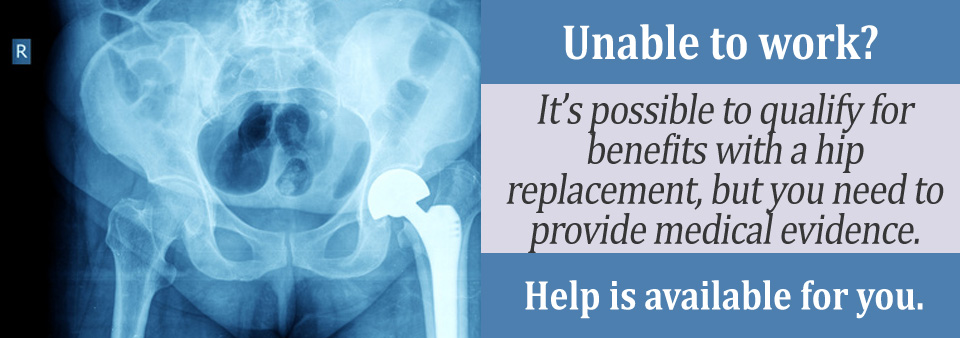Hip replacement surgery, or hip arthroplasty, is a common surgical procedure in the United States. In fact, the annual number of hip replacements in patients over the age of 45 doubled between 2000 and 2010, from 138,700 to 310,800 surgeries.
While most patients recover from hip replacement surgery, a small number of people experience complications, such as hip replacement failure.
If you have had a hip replacement and are unable to work to your full capacity for at least 12 months following your surgery, there could be financial help available to you.
The Social Security Disability Insurance (SSDI) program was created to assist those who have become disabled due to complications from hip replacements.
What Exactly is a Hip Replacement?
A hip replacement surgery is a procedure in which a damaged portion of the hip is removed and replaced with an artificial joint. The primary reason for a hip replacement is arthritis.
The surgery is usually performed on patients who have reduced mobility and severe, chronic pain. Typically, these patients have exhausted all other treatment options, such as physical therapy, medications, and steroids.
Hip replacements are considered to be one of the most successful surgical operations. In most cases, hip replacements improve mobility and reduce pain. For patients who undergo hip arthroplasty and follow through on rehabilitation, over 90% experience health improvements.
As a general rule, hip replacement patients report decreased pain, increased mobility, improvements in their activities of daily living, and a better quality of life.
Despite the excellent prognosis of those patients who undergo hip replacements, there are risks involved and not all patients experience a full recovery.

What Symptoms Do I Need to Qualify?
As a general rule, the Social Security Administration (SSA) considers a hip replacement surgery to be a success. While recovery and rehabilitation may take some time, the overwhelming majority of patients can regain mobility and bear weight well within one year from their surgery.
Typically, social security benefits are reserved for those patients who experience long-term difficulty with their hip replacement. The “Blue Book” is a manual used by the Social Security Administration (SSA) to determine benefit eligibility.
The two primary listings that may apply to hip replacements fall under the musculoskeletal section of the book. Here are some signs that your Hip Replacement might qualify you for disability benefits:
- If you experience a significant dysfunction of your joint, such as deformity, chronic joint pain, and stiffness with signs of limitation of motion, you may qualify for financial assistance.
- The SSA considers benefits if you have had reconstructive surgery on a weight-bearing joint, such as the hip, and you have been unable to return to ambulation. If you continue to experience difficulty walking without assistance and it has been a year since your surgery, you might be eligible for benefits. For example, if you depend on the use of a walker, cane, crutches, or a wheelchair to get around, you will likely be considered for SSDI benefits.
- If you have experienced complications from your hip replacement surgery such as blood clots, infections, a bone fracture, or dislocation of the hip, you may qualify for benefits.
- If your condition is not severe enough to meet the “Blue Book” listing requirements, but you are still unable to work, you may qualify for disability benefits by utilizing a vocational allowance. The SSA will evaluate you to determine your Residual Functioning Capacity (RFC).
Do I Qualify for Social Security Benefits?
To be eligible for Social Security benefits, your medical records will need to show that your health difficulties are severe enough to prevent you from working at a level which would support you. Additionally, your illness needs to be expected to be disabling for at least 12 months.
As previously mentioned, you will typically heal from a hip arthroplasty well before the one-year anniversary of the surgery. However, if you continue to have difficulty with mobility and work following 12 months, you may qualify for social security benefits.
What Information Will I Need to Provide?
When applying for Social Security, you may be asked to provide the following:
- Confirmation of your diagnosis from an Orthopedist, including several physician notes over the course of your illness
- Physical examination reports from a doctor giving a detailed description of the findings, including your ability to perform daily activities of living, a list of assistive devices needed, and general measurements of joint motion
- X-rays, CT scans, MRIs, or other imaging results over time. Imaging results before your hip replacement and after your hip replacement are vital.
- Orthopedic surgical notes
- Documentation of your rehabilitation course
- Notes from any other health care provider involved in your care, such as physical therapist, occupational therapist, or other health care provider
If you are missing any of the above medical records, you should speak to your doctor’s office or hospital immediately. The more medical evidence that you have on your side, the better your chances of receiving financial assistance benefits related to your hip replacement.
What’s Next?
If you have had a hip replacement and you believe that you may qualify for Social Security benefits you should contact a disability advocate or lawyer in your area. A qualified attorney can help you navigate the Social Security application process.